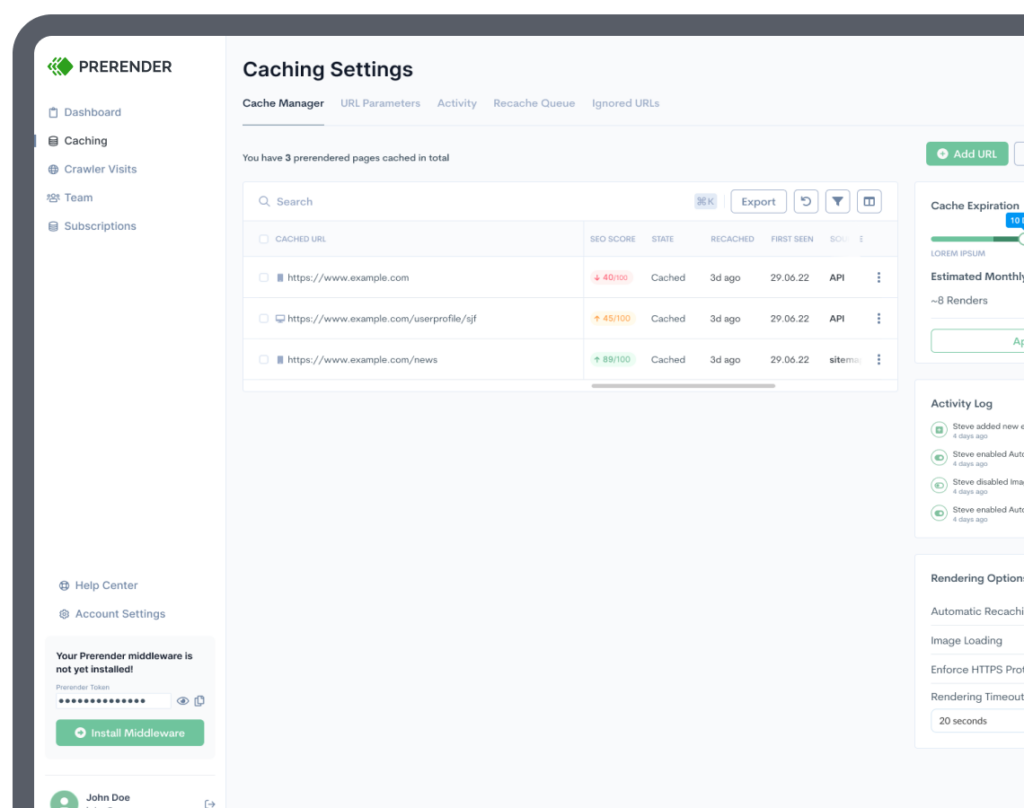AngularJS SEO Optimization
Don’t let your framework hold you back. Make your AngularJS site search-friendly with seamless prerendering that boosts visibility and ensures smooth crawling so the right customers can find you, fast.
Use prerendering middleware to deliver fully rendered, cacheable HTML snapshots of your AngularJS application to search engine crawlers. Improve indexability and crawl efficiency by resolving JavaScript rendering challenges on the server side. Serve SEO-friendly content without modifying your client-side architecture, ensuring faster discovery and better rankings.
AngularJS Explained
Angular is a JavaScript framework used to build enterprise-level web applications and websites. (It enables you to build scalable and unique web experiences in a straightforward way.) Install Prerender and enjoy all the benefits of using Angular without compromising your SEO performance.

AngularJS Benefits
Unlike React or Vue, Angular is an independent solution. While there might not be the need to rely on external libraries, independence comes with a price.
Angular is heavier than other frameworks, making it load slower for users, as they have to download and execute bigger files. To compensate, Angular provides a component-based approach to client-side rendering, only updating the elements the visitor interacts with, making the page faster to navigate.
In saying this, search engines still don’t get to experience any of these benefits because Angular injects your content onto the page on rendering time. So, when search bots download your page, they can only see an empty file of JS directives, resulting in a low PageSpeed, crawling issues, and poor rankings.
Traditionally, you could solve this roadblock by changing your code to Angular Universal to enable server-side rendering, but it would require you to re-write your application, invest in server equipment and space, and spend hundreds of engineering hours before seeing any results. Fortunately, times have changed.
You can use Prerender.io to get immediate time to value (TTV) from your technical SEO efforts without changing a single line of your website’s code.
AngularJS and Prerender
Although AngularJS makes it possible to build high-performing websites that customers love, it comes with a drawback: search engines can’t read it.
For Google to understand your web pages, it needs to render your pages, which takes more time and resources. This extra step adds a lot of JavaScript SEO problems, requiring a lot of money, expertise, and time to handle.
Prerender, on the other hand, eliminates that frustration. We turn your Angular pages into static HTML documents ready to be crawled and indexed. In just a few hours, you will start to experience all the SEO benefits you’ve worked for.
No matter how fast your AngularJS web pages are, when Google has to render your pages it’ll still negatively affect your page speed scores and Core Web Vitals (CWV). Prerender generates a fully rendered and functional HTML version of your URLs and serves them to search engines in 0.03 seconds on average. This boost in loading speed gets your CWV scores to near perfect.
Google is forced to render your page before finding new links to crawl, wasting your crawl budget waiting for your content to appear. By taking care of the rendering process, Prerender delivers your links instantly, allowing search engines to crawl your site 9X faster. This process will signal to Google that your server can handle more frequent crawls, which increases your crawl budget.
Google needs to find and read your pages before indexing them.
Indexing is a task that AngularJS truly complicates, resulting in a big portion of your site being ignored and the other portion only partially rendered. By dynamically rendering your pages, Prerender ensures every link, word, image, and SEO tag is indexable from the start without compromising user experience.
With a near-zero development investment, Prerender.io will ensure your JS pages are fast, crawlable, and easy to read for all search engines.
Get started with 1,000 URLs free.

All your Angular questions answered.
Crawl budgets are limited, and Google wastes a lot of your budget trying to download, execute and render Angular code. This delay results in timeouts, which leads to the crawler leaving, and most of your URLs being undiscovered.
And for single-page applications (SPAs), it’s even worse because Google can’t interact with your site like humans do. So, when Google downloads your site files, bots see an empty page and won’t be able to find new links to crawl.
Learn how Prerender.io solves AngularJS SEO problems in just a few hours.
Unlike server-side rendering and hydration, Prerender.io only blocks common analytics to avoid messing with your data. All JS files are fully loaded and rendered on our servers, so there’s no workload for Google (besides indexing).
Prerender.io can use a submitted sitemap or list of URLs to start rendering and caching your pages. But for this to work, you need to know which URLs to send in advance (which isn’t always possible). Prerender.io will identify the user-agent as a bot, render the requested page and caching it before sending it.
No setup or configuration required.